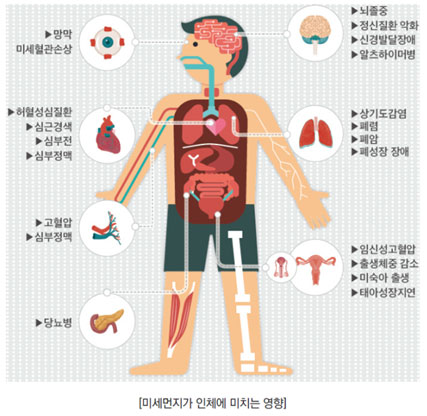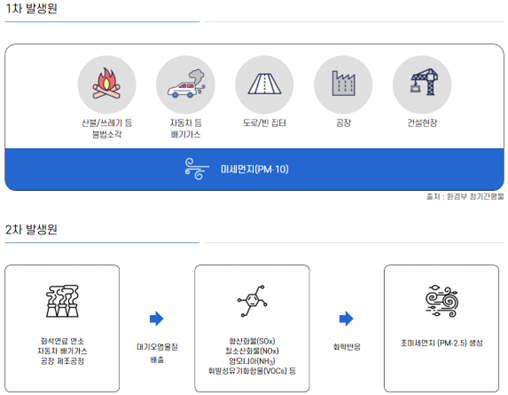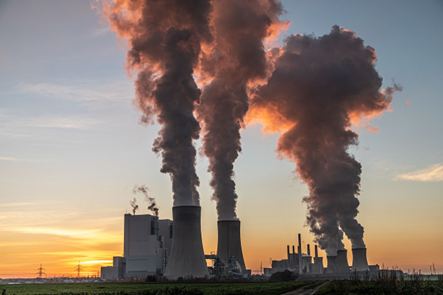Through various media, many people have learned that the current fine dust situation in Korea is not that good. Some people don’t even care about this situation thinking that they are separated from it, while others decide whether they go out or not by checking the fine dust level. However, the fine dust problem has become one of the most serious social problems that we cannot ignore just because we are young and healthy. Contrary to the common idea among people that fine dust conditions would be better when it rains, it is hard to say that fine dust conditions have improved even though there has already been a lot of rain recently. For these reasons, it seems that we need to pay attention to the facts we didn’t know like the exact reason and result of the fine dust and to spend time considering solutions for this situation.
About fine dust
Fine dust is dust with a diameter of 10㎛ (micrometer, 1㎛= 1000 1/1000) or less and is called PM (Particulate Matter) 10. This refers to the small dust that flies during yellow dust or severe smog in China. In addition, it refers to a particulate substance with a diameter of 10㎛ or less floating or scattered in the atmosphere for a long time as a very small harmful substance that cannot be seen by our eyes. Among various kinds of fine dust, fine dust with a smaller particle size is called ultrafine dust and is called PM2.5 as dust with a diameter of 2.5㎛ or less. Yellow dust is a phenomenon in which dust raised to the high atmosphere by strong winds from the Inner Mongolia Desert in China flies to Korea in a westerly wind. If the yellow dust phenomenon is severe, the color of the sky turns yellowish brown, and at the same time, dirt blocks the sunlight, resulting in poor visibility. Yellow dust can have bad effects on our health because it can include heavy metals such as lead and cadmium and microorganisms such as bacteria, fungi, and viruses due to China's rapid industrialization. According to Professor Kwon Yong-soo of Respiratory Medicine at Chonnam National University Hospital, more than 40 percent of adults experienced uncomfortable symptoms and it means that there are many health damages due to the yellow dust. It is known to cause a lot of damage to the eyes and respiratory organs as there are the most symptoms of eye pain and congestion, followed by a sore throat. It is known that the number of patients who are hospitalized because of respiratory and cardiovascular disease increased especially on the yellow dust days. It means that the harmful damage to health due to the yellow dust is a serious problem. Unlike yellow dust, fine dust is mainly caused by artificial pollutants emitted by the use of fossil fuels used in automobiles, factories, and homes. Fine dust contains heavy metals, harmful chemicals, and other harmful substances. Exposure to fine dust can cause or worsen heart and lung-related diseases, and as a result, it can lead to an increase in death. In the short term, symptoms such as asthma attacks, acute bronchitis, and arrhythmia may worsen, and the risk of cardiovascular disease, respiratory disease, and lung cancer may increase if exposed for a long time in places with high fine dust concentrations.
 |
|
the effects of fine dust on the human body (according to the Korea Centers for Disease Control and Prevention) |
The causes of fine dust can be divided into natural and artificial sources. Natural sources include dust, salt from seawater, and pollen from plants to name a few. Artificial sources include smoke generated while using fossil fuels, automobile exhaust gases, flying dust generated at construction sites, raw materials and subsidiary materials in the form of powder in factories, powder components in handling processes, smoke from incinerators, and other harmful pollutants. The causes of fine dust also can be divided into first and second sources. Details are as follows. (Refer to the infographic)
 |
When you search for today's fine dust levels at the Korean representative portal site, Naver, you can know the real-time fine dust status of the corresponding day. Even if it is the same day, time, and area, there may be a difference between the fine dust status based on the US.AQI and the fine dust status based on WHO. We need to look into the differences in fine dust measurement ratings between the US.AQI and WHO. First, the “US.AQI” means the United States Air Quality Index. AQI (Air Quality Index) is a measure of the degree of air pollution affecting the public. Higher AQI indicates worse effects on people. Many countries used AQI using different measurements and these days, Chinese or American ones are commonly used. The U.S. air quality index measures the weight of six pollutants: ultrafine dust (PM2.5), fine dust (PM10), ozone (O3), nitrogen dioxide (NO2), carbon monoxide (CO), and sulfur dioxide (SO2). The U.S. AQI is provided by the United States Environmental Protection Agency-EPA, an administrative agency of the U.S. government aimed at protecting the health of the people and the natural environment. The scale is as follows: 0 to 50 is good, 50 to 100 is normal, 100 to 150 is unhealthy for sensitive people, 150 to 200 is unhealthy, 200 to 300 is very unhealthy, and 300 to 500 is dangerous. A value above 300 means hazardous air quality, and a value below 50 means good air quality. The next fine dust measurement rating is WHO (World Health Organization). This is the lowest level of increase in mortality from cardiopulmonary diseases and lung cancer caused by fine dust by the WHO. Ratings according to national circumstances is specified according to the recommendation criteria and provisional goals. Fine dust concentrations which are rated as good or normal by the US.AQI is often considered as exceeding the recommended value and by this, we can notice that WHO standards are more sensitive to fine dust.
 |
The reason why fine dust became a serious problem these days
 |
The number of ultrafine dust warnings number of alerts issued in each region of the country from January 1 to March 20 is 153 times which was a number of significant increase in comparison to last year. Recently, in Korea, high-concentration ultrafine dust is caused by the combination and accumulation of domestic and overseas fine dust. Many experts say that the main cause of the internal high-concentration ultrafine dust is the economic activities increased after the relaxation of the COVID-19 situation. It was expected that artificial activities would increase compared to two years ago when social distancing policies were implemented. The increased number of artificial activities leads to an increase in air pollutant emissions. And consequently, it leads to an increase in air pollutant emissions, which increases the probability of fine dust generation. Many people may think of “China” as a country associated with the inflow of fine dust from foreign countries. Though this is partially true, however, it is hard to conclude that the recent deterioration of the situation of Korean fine dust is because of the “recent” Chinese fine dust. Even in December 2022, when China lifted the blockade, the average concentration in Korea was 20 micrograms, the lowest ever observed among past Decembers. December 2022 was an unusually cold month due to a cold Siberian high pressure, in addition the northwest winds from this Siberian high pressure scattered pollutants. However, in recent years, this Siberian high pressure has turned into a warm and stagnant nature, and it has settled over East Asia, which has led to the slow west wind flooding of pollutants accumulated in China, which has not been scattered. Therefore, the recent Korean fine dust situation is associated with China, but it is not because of the effect of recent Chinese fine dust but because of long-standing pollutants in China that have been introduced into Korea recently due to changes in the weather. Other than that, while energy conversion is needed to solve the fine dust situation, it has become difficult to implement it as energy supply and demand has become unstable recently. Rather, the use of fossil fuels such as coal is increasing rather than the energy conversion to new energy sources, and the fine dust situation is worsening.
Cases of Fine Dust Damage
The number of premature deaths worldwide from air pollution continued to rise to 6.5 million a year. The death toll from fine dust was estimated to have increased from 2.9 million in 2000 and 4.2 million in 2015 to 4.5 million in 2019. Early deaths from traditional pollution such as indoor air pollution and water pollution are on the decline, while deaths from modern pollutants such as air pollution and occupational environment pollution are on the rise. London smog incident in 1952 was representative of the actual harm due to fine dust. The cold weather and windless days continued for about 4 days making heavy smog from domestic and factory coal cover London. This smog was first reported in London as a smog classified as "Sulfide Smog" and is also called London-type smog. Smog refers to a variety of air pollution in the troposphere, ranging from smoke fog to opaque odor air conditions due to pollutants, and sulfide smog mainly refers to smog generated when burning coal in combustion facilities or general caustic heating facilities in factories and buildings. This London smog killed more than 4,000 people and caused more than 100,000 people to suffer from respiratory diseases. At that time, the concentration of fine dust was 4,500㎍/㎥, which is 40 to 50 times that of the day when fine dust is severe in Korea. Most of the deaths were young, old, or chronic respiratory disease. This means that fine dust is more fatal to people who are suffering from underlying diseases. Also, there is research that fine dust prevents adolescents’ healthy development. After eight years of tracking 1,759 growing adolescents in California, U.S., children living in areas with severe fine dust are more likely to have poor lung function as adults due to poor lung growth than others. On November 3, 2019, air pollution in the Indian capital, New Delhi, worsened to a level that could lead to respiratory diseases, and government officials advised citizens not to go outside. The cause was the release of various harmful substances into the atmosphere due to the huge number of ashes from burning harvested rice fields in the state near New Delhi, and firecrackers set off in various parts of the country to commemorate the Hindu Diwali festival. This fine dust situation caused schools to take a leave of absence, caused more than 30 passenger planes to bypass the city and caused the paralyzing of construction sites.
Then, how about the status of damage due to fine dust in Korea? There has been a steady death toll because of fine dust, and in 2019, the total number of deaths from fine dust reached 21,837. Fine dust can also have bad impacts on outdoor workers’ health. Mr. Kim, a sanitation worker in his 60s cleaned up the streets as usual in Okcheon-dong, Chuncheon-si, when fine dust levels were "very bad." He said, “I want the policy that guarantees the rest of sanitation workers during fine dust warning alerts, just as during the heat wave or cold wave warning.” Delivery rider Lee (27) said, “Since dust gets stuck in the eyes often during the yellow dust season, sports sunglasses become a necessary item among delivery riders. When I am waiting for the delivery call, I inhale a handful of dust on the street because there is no specific indoor place to wait.” These examples show that despite the severe situation of fine dust, outdoor workers cannot be protected and they are exposed to fine dust consistently. According to the guideline of the Ministry of Employment and Labor, appropriate rest is provided, and the heavy work schedule of ordinary workers can be adjusted or shortened when the fine dust warning stage is reached. However, it is considered a big problem because it is just a recommendation level, and management and supervision are also not properly conducted in that most workplaces are not followed.
Measures to resolve fine dust in Korea and abroad
The government has established a comprehensive plan for fine dust management (2020-2024) to reduce domestic emissions, strengthen international cooperation, protect public health, prepare a policy base, and raise public awareness. The government said it will invest about 20 trillion won in the planned period to meet the goals of the measures set up, consisting of five areas, 42 projects, and 177 detailed projects. In the industrial sector, detailed measures such as designating a large amount of fine dust emission area as an air management area, strictly managing it, monitoring the status of emission management at workplaces, and strengthening crackdowns are proposed. In the transportation sector, it said it will accelerate the withdrawal of old diesel cars, strengthen the management and inspection of diesel cars, and expand the supply of low-pollution cars that emit fewer air pollutants than ordinary cars. In the non-road transport sector, measures such as reducing fine dust in ships and ports, strengthening standards for emission of construction and agricultural machinery, and promoting airport fine dust reduction are proposed. The power generation sector said it would expand the foundation for improving coal power plants and converting eco-friendly energy, preventing illegal incineration of waste in rural areas, and supporting the replacement of old home boilers with eco-friendly boilers. In addition, it includes details such as strengthening international cooperation, protecting public health, strengthening policy bases, and raising public awareness. In Germany, the standard for fine dust is defined as an average of 50μg/㎥ for 24 hours and an average of 40μg/㎥ per year. If this fine dust level exceeds this standard and the local authority does not take any action, a lawsuit can be filed with the local authority. Similar to Korea, Japan is reducing fine dust by supplying eco-friendly cars, installing smoke reduction devices, and supporting early decommissioning. China's Beijing imposes 'traffic inducement levy' on motorists. It is said that vehicles entering the city are subject to a "smog tax" of up to 50 yuan (about 9,000 won) per day in the name of congestion charges.
Fine dust has become a problem that cannot be detached from our daily lives. There are no detailed solutions for the cause of fine dust. Also, there is no effective way to solve the negative results of fine dust. In this situation, we need to recognize our circumstances and practice things we can do in our everyday lives. Fine dust is not a personal problem but the problem which is pan-national, artificial, and natural. Just one person cannot solve this situation. So, both the country (the government) and the public should make an effort to solve it. The steady increase in deaths from fine dust suggests that the fine dust problem has now become a problem that cannot be concluded simply as "bad air condition" and concluded that it is not related to itself. As mentioned earlier, it is necessary to know that fine dust is not a problem that can be solved simply by individual citizens' efforts, but only by the government, the world, and the people.
김서연 seoyon1229@naver.com
<저작권자 © 인하프레스, 무단 전재 및 재배포 금지>

![[보도] 제43대 총학생회 후보자 공청회 개최돼](/news/photo/202404/11686_5015_2626.png) [보도] 제43대 총학생회 후보자 공청회 개최돼
[보도] 제43대 총학생회 후보자 공청회 개최돼
![[보도] 제43대 총학생회 후보자 공청회 개최돼](/news/thumbnail/202404/11686_5015_2626_v150.jpg)
![[보도] 총학생회장 선거 열려···학생사회 대표자는?](/news/thumbnail/202403/11668_5014_266_v150.jpg)
![[보도] 무전공·계열제 논의···학생은 어디에?](/news/thumbnail/202403/11666_5011_2238_v150.jpg)
![[보도] 인하 70돌, 다양한 행사 이어져](/news/thumbnail/202403/11663_5009_165_v150.jpg)
